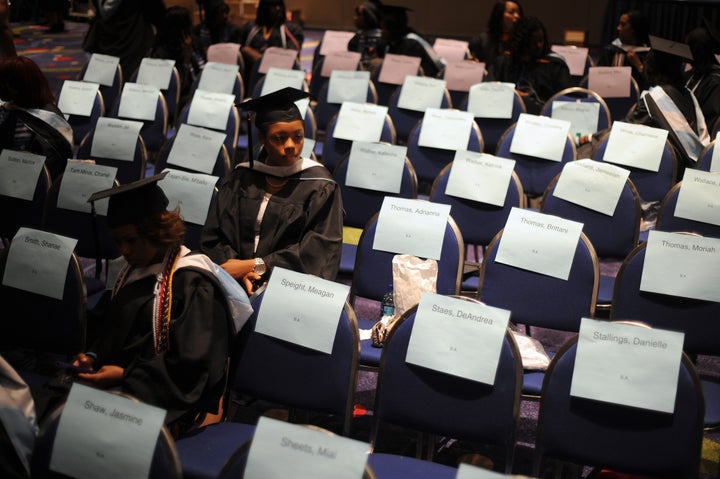
When the housing bubble burst, the resulting foreclosure crisis was a disaster for black and Latino families, who lost 53 percent and 66 percent of their median household wealth, respectively, between 2005 and 2009. As a result, the racial wealth gap is widening, with white households enjoying 18 times as much wealth as their Latino counterparts, and 20 times more than African-American households.
There is every indication that the bursting of the student debt bubble, like the housing bubble before it, is imminent. And when it happens, it will send shockwaves throughout the financial markets. People of color will be especially vulnerable.
Although education is widely viewed as a way up and a way out for poor, working-and middle-class students, the prohibitive cost of college tuition has created a virtual debtors' prison for many. Loan defaults and delinquencies are on the rise in America, and are only expected to worsen.
A recent report from Moody's Analytics says that tuition has doubled since 2000 -- that's a 10 percent increase every year -- causing student debt to accelerate during the recession. In contrast, other types of consumer debt such as mortgages, credit cards and auto loans have decreased sharply. Outstanding student loans have increased 25 percent since 2008. Student debt now exceeds total credit card debt, and is likely to reach $1 trillion this year, with the average debt for a bachelor's degree at $24,000.
To add to the problem, unemployment is high and there are no jobs for recent graduates. And in the lucrative for-profit college industry where students of color predominate at 54 percent, graduation rates are lower than traditional institutions of higher learning. So, students leave without the benefit of a degree, but with the debt burden just the same.
For blacks and Latinos -- who suffer from lower pay and double the unemployment, and must assume larger debt loads to pay for school -- the deck is stacked against them. According to a Georgetown University study, blacks and Latinos earn less than whites, even with advanced degrees. Moreover, members of these groups who have earned a master's degree earn less than whites with a bachelor's. It is no wonder that their default rates are higher. In a 2007 survey, black students had a default rate five times higher than whites and nine times higher than Asians, with the Latino rate double that of whites and quadruple that of Asians.
This talk of student default goes far beyond dollars and statistics. These are human beings who are thrown into hopeless life situations because the tuition is too damn high. Recently I had the pleasure of reviewing the new film Default: The Student Loan Documentary. I appreciate the film's clarity in spelling out the nature of this American crisis and its impact on ordinary people. Borrowers break down and cry in front of the camera as they reveal the amount of money they owe in student loans. Some were brought to financial ruin as the result of prohibitively high monthly loan payments, compounded by illness or some other setback. Others are unable to get married and start a family because their loan payments prohibit it. One has to take a step back and ask if this is really what America has become.
"The private loan industry, they don't care about people," said Carmen Berkley, who appeared in the film. Carmen, who is African-American, has $80,000 in student loan debt, in addition to $5,000 in credit card debt and thousands in medical debt due to an illness. "I told them, 'Look I don't make that much money. I make $34,000 a year. There's no way I can spend 600 or 900 dollars a month just for loans.' And they said, 'Well there's nothing we can do about it.'"
Default touches on far more than the inability of college graduates to afford to repay their loans, and the financial ruin they face as they must choose between paying their rent, eating or paying off their mortgage-sized school debt. Although that heart-wrenching part of the story by itself is enough to warrant a documentary, the problem is even deeper, as the movie points out.
Ultimately, the student debt crisis is a product of the union of greed and corruption -- the banking industry and the politicians they have purchased for the purpose of carrying their water. Colleges and universities do their part by hiking up tuition far in excess of inflation. Meanwhile, private lenders exploit financial realities where students can no longer work to pay their way through college, and federal loans no longer pay for most or all of a college education. Moreover, these lenders benefit from loan defaults, as the fees and penalties that rack up can double or triple the amount of the original loan.
Much of this new financial crisis really speaks to the power of the lenders, who receive their money's worth from their investment in Congress. There is a reason why student loans are the only type of debt that cannot be discharged in a bankruptcy. The banks paid for the laws that exempt such loans from fundamental consumer protections. Even gambling debts can be discharged in a bankruptcy, as is mentioned in Default.
And in the irony of all ironies, the banking institutions that were "too big to fail" enjoy their federal bailout funds. This, as they continue to extract additional profit from human suffering, whether by exploiting homeowners with predatory mortgages, or bilking students with predatory school loans. These bailout recipients are making everyday people suffer, yet where is the bailout for the students?
